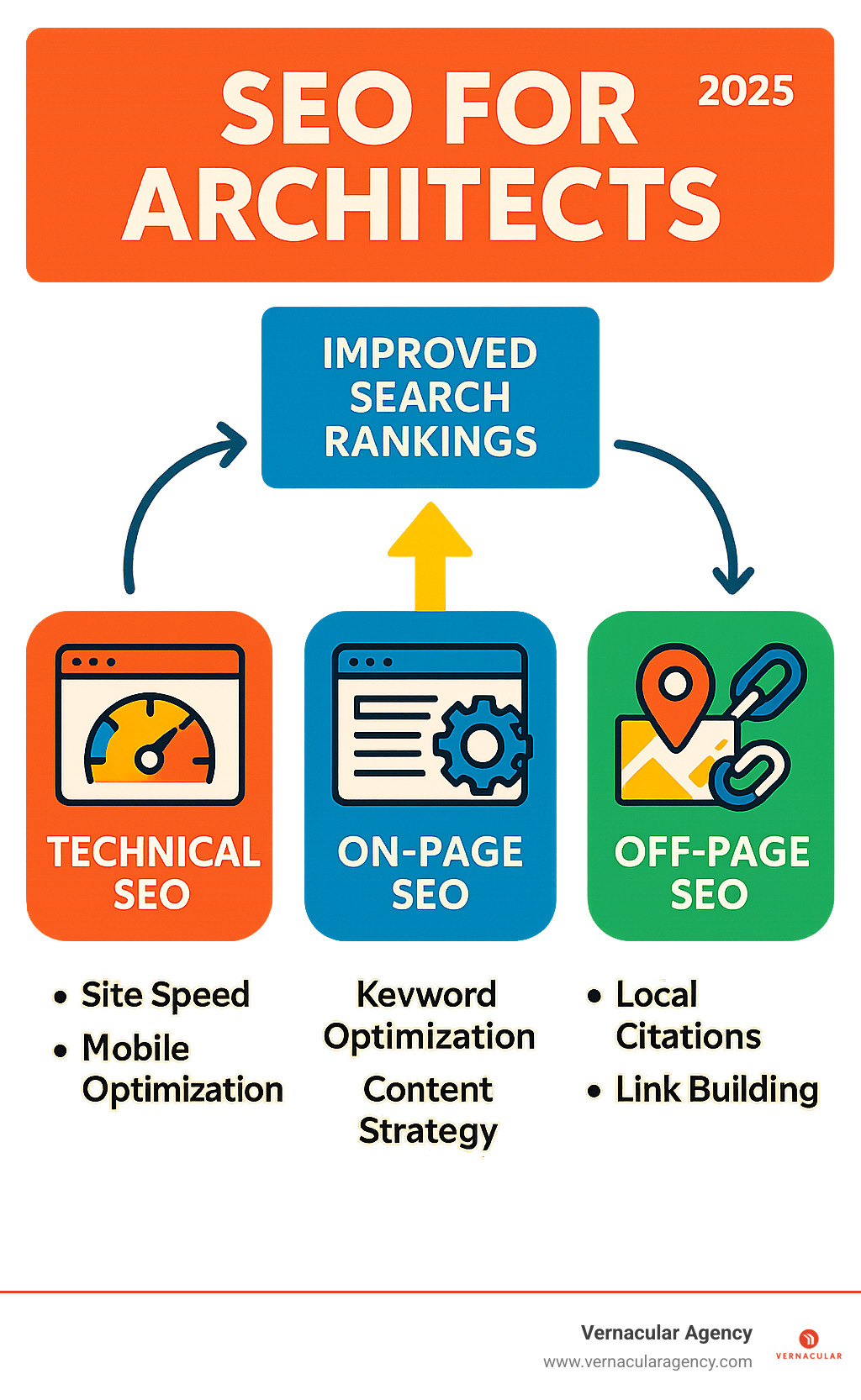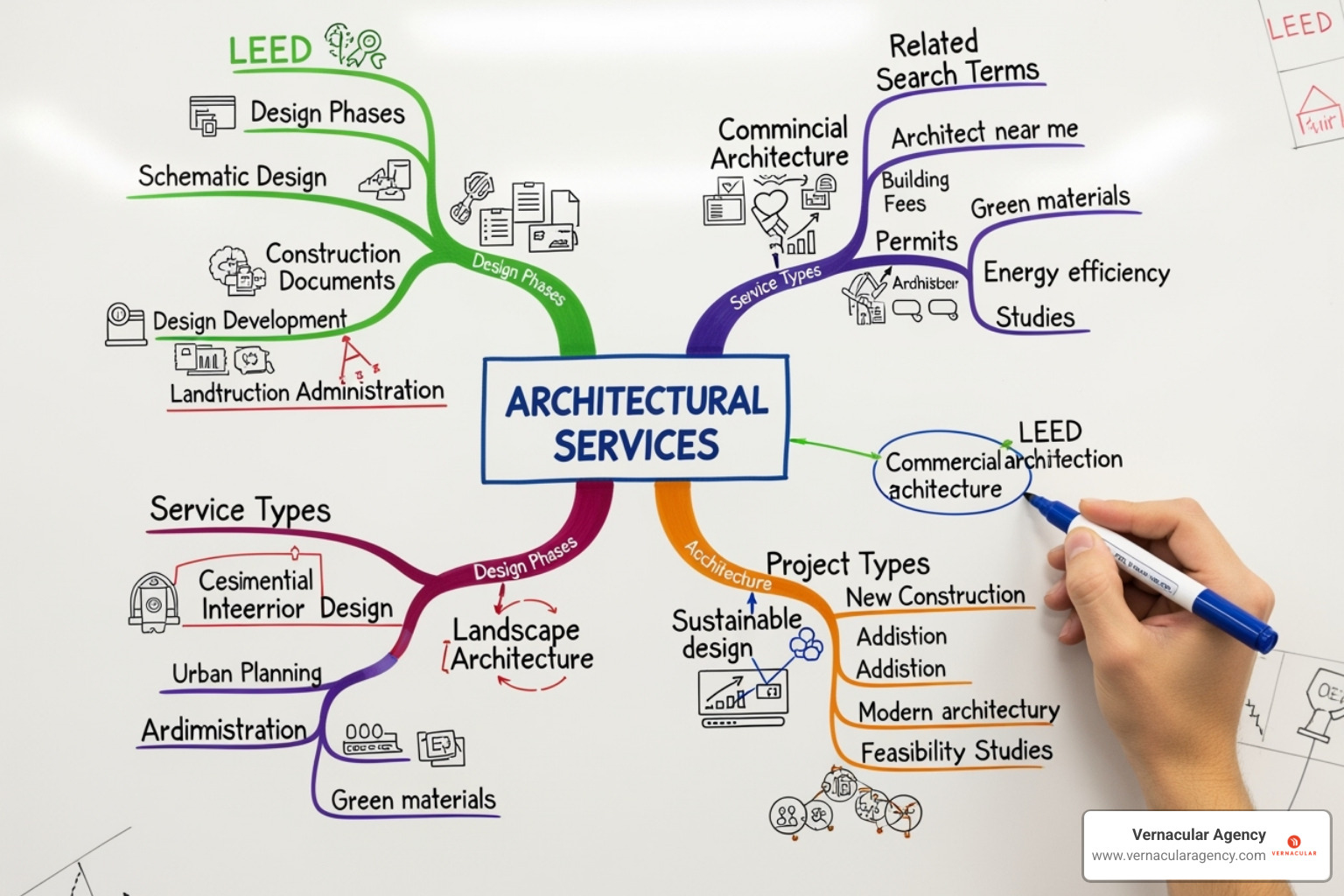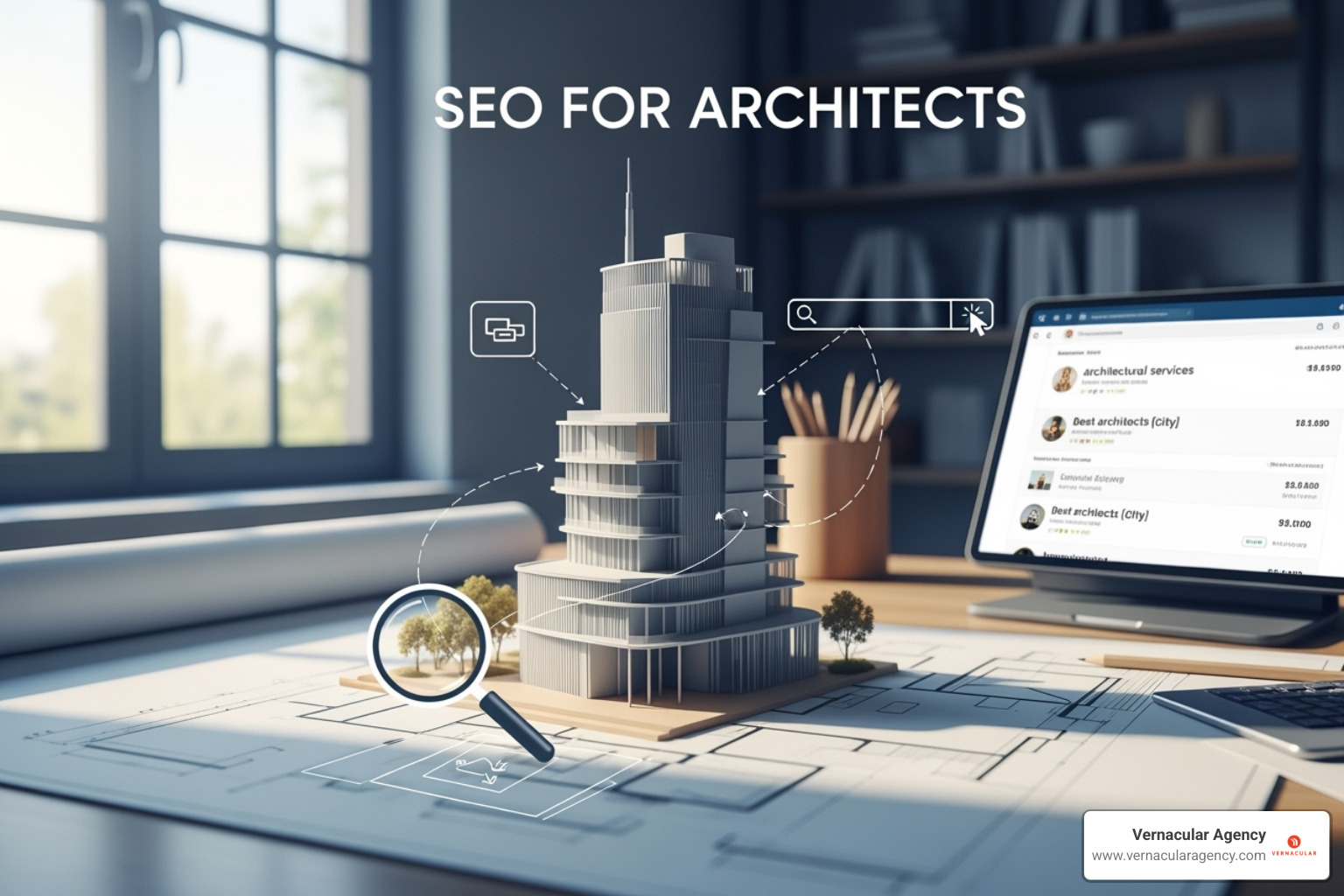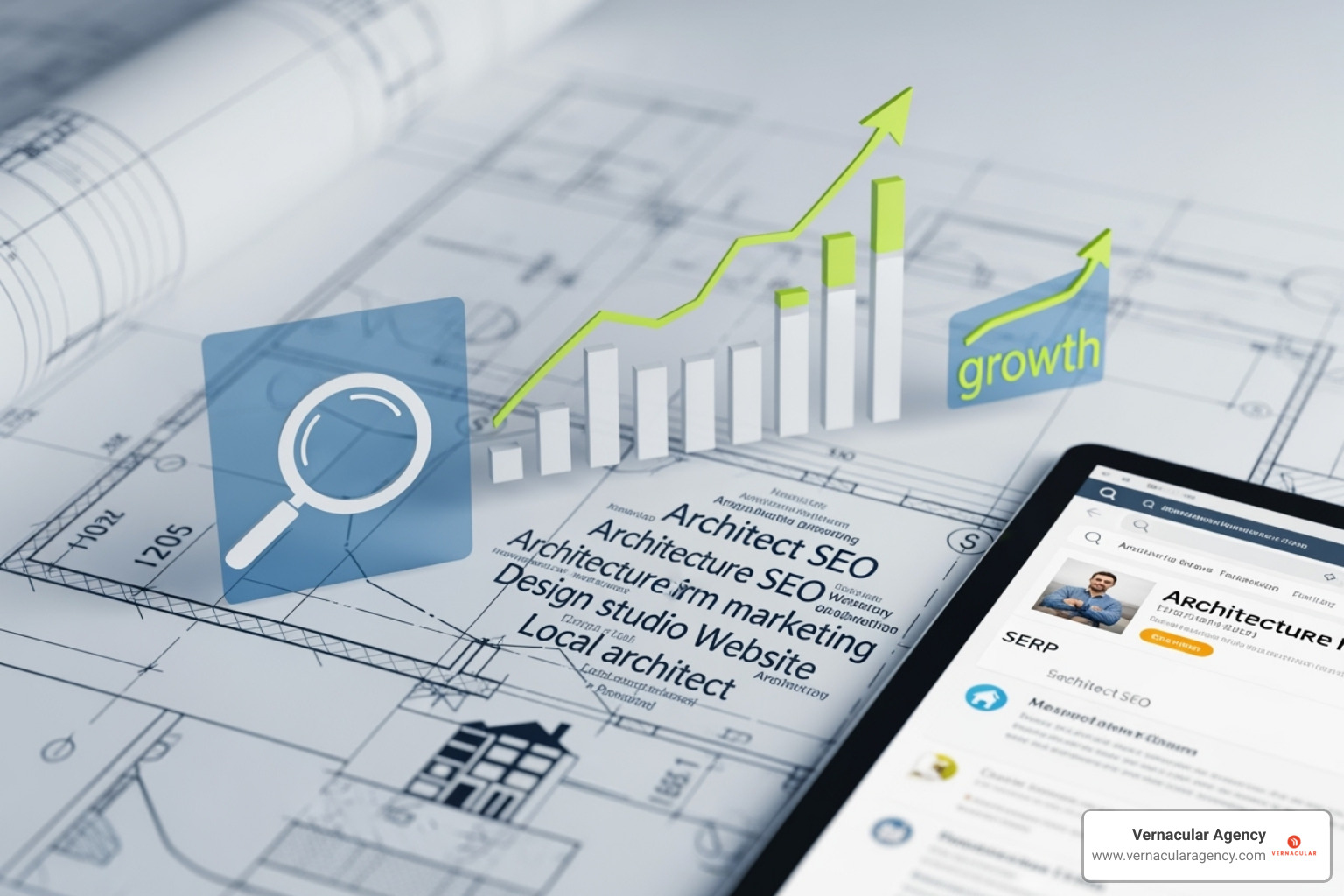SEO for architects optimizes your firm's website to rank higher in search results when potential clients look for architectural services. Here's what you need to know:
Essential SEO Strategies for Architects:
The stakes are high: the top 3 Google positions capture 55% of organic clicks. For architects in local markets, this visibility directly translates to client inquiries.
While referrals are important, potential clients research online first. You need to appear for searches like "modern architect in Boston." Local searches are crucial: nearly half have local intent, and 88% of consumers contact a local business within 24 hours of a mobile search.
Many architects treat their websites as passive portfolios. SEO transforms your site into an active, 24/7 lead generator, attracting qualified prospects in your service area.
With nearly 15 years in digital marketing and a background in shelter magazine editing, I've helped many architectural firms implement SEO for architects strategies that drive measurable results and attract ideal clients.

Like designing a building, SEO for architects starts with a solid blueprint. To attract clients, you must understand what they search for online. This requires strategic planning based on real data.

Keyword research means understanding your clients' search terms. Do they search for "sustainable home design" or "green architect near me"? The difference reveals their stage in the decision-making process.
Your content strategy flows from this research. Knowing the questions allows you to create compelling answers that showcase your expertise and value.
Google estimates over 128,000 keyword variations for "architect." The trick is finding which ones matter for your business.
Search intent is key. A search for "architecture" is informational, while "residential architect Boston" shows intent to hire. Both have value at different stages of your marketing funnel.
Long-tail keywords are goldmines. While "architect" gets millions of searches, a specific phrase like "sustainable residential architect in Portland Maine" attracts highly qualified local leads ready to start a project.
Location-based keywords are crucial, as nearly half of all Google searches have local intent. Targeting "architects in [your city]" helps you compete against larger national firms.
You don't have to guess. Tools like Ahrefs and even free Google tools provide data on local search terms, volume, and ranking difficulty.
This research is the foundation for your site's pages and blog posts, forming a key part of a successful Marketing Plan for Architecture Firm.
Once you know what people search for, you can create content that answers their questions and showcases your firm. This is where SEO for architects gets creative.
Your project showcases should be compelling stories, not just pretty pictures. Detail the client's challenge, your design solution, and the project's unique aspects. This storytelling naturally incorporates keywords and provides value.
Case studies are powerful for demonstrating your problem-solving skills. Walk readers through your design process, explaining material choices, design features, and budget management. This positions you as an expert and shows your value.
Blogging for architects is powerful. Posts on design trends, local codes, or the client process attract people in early research stages. These posts rank well and introduce your firm to future clients.
As architecture is a visual field, visual content is non-negotiable. High-quality photos, 3D renderings, and video walkthroughs engage visitors and keep them on your site longer, signaling quality to Google.
A key tip: long-form content (over 1,200 words) tends to rank better. It allows you to explore topics thoroughly, use related keywords, and establish expertise. Go deep on subjects that matter to your clients.
The key is creating content that serves both SEO goals and client needs. Focus on helping people understand design, and rankings will follow. This is essential for an effective Architecture Portfolio Site that generates leads.
With your keyword and content blueprint ready, it's time to build your website's structure. This involves optimizing your site for search engines while maintaining a beautiful design.
Like a building that meets code, your site needs to look amazing and function flawlessly. This involves two areas: visible on-page elements and the underlying technical foundation that helps search engines rank your site.
The goal is an exceptional user experience with mobile optimization and fast site speed. A visitor's first impression must be perfect on any device.

On-page SEO includes all elements you control directly on your pages. Google reads these to understand your content's value, making them crucial for effective SEO for architects.
Your title tags must be unique, compelling, and 50-60 characters long. Include your main keyword near the beginning, like "Residential Architecture Services in Portland, Maine" instead of just "Services."
Meta descriptions are your 150-170 character pitch in search results. While not a direct ranking factor, a good description boosts click-through rates, which does influence rankings.
Header tags (H1, H2, H3) structure your content. Your H1 should contain your primary keyword, while H2s and H3s break up content for readability, helping users and search engines.
A clean URL structure is vital. Use descriptive URLs like "yourfirm.com/residential-design-seattle" instead of confusing ones like "yourfirm.com/page123?id=xyz."
For architects, image optimization is critical. Compress images to under 500KB, use descriptive file names (e.g., "modern-farmhouse-design-kennebunkport.jpg"), and add descriptive alt text. This aids accessibility and gives Google context.
An internal linking strategy connects related pages on your site. For example, link from a blog post on sustainable materials to your green architecture services page. This guides visitors and shows Google page importance.
These optimizations transform your Website Design for Architects from a simple portfolio into a powerful lead generation tool.
While on-page SEO is what visitors see, technical SEO is the invisible foundation essential for search engine success.
Mobile-first indexing means Google ranks you based on your mobile site. With over half of web traffic from mobile, your site must be flawless on all devices.
Page speed optimization is non-negotiable. A site taking more than three seconds to load loses visitors. We achieve speed by compressing images, cleaning code, and using caching. A fast site improves user experience and rankings.
HTTPS security encrypts data between your site and its visitors. It's a basic expectation that builds trust with Google and users.
XML sitemaps are like blueprints for search engines, showing your site's structure. A robots.txt file guides them away from non-public pages.
Schema markup is code that helps search engines understand your content. For architects, we can mark up services, reviews, and project details to create eye-catching search listings with features like star ratings.
To avoid duplicate content, use canonical tags to tell Google which page is the primary version. This prevents your pages from competing against each other in search results.
Getting these technical elements right creates a solid foundation. For inspiration, check out these examples of Great Architecture Websites.
With your site's foundation built, it's time to connect it to the digital landscape. For architects, this means focusing on your local community and building your reputation online, establishing your presence in your neighborhood and the wider industry.
This phase of SEO for architects builds trust and authority. Online "referrals" like local citations and quality backlinks signal to Google that your firm is credible.

Local SEO is powerful for architects since most clients are local. With 46% of Google searches being local and 88% of consumers acting within 24 hours of a local mobile search, not optimizing for local means losing clients to competitors.
The cornerstone of local SEO is Google Business Profile optimization. This free Google listing is often a potential client's first impression. We ensure it's complete with your category, service area, contact info, hours, and captivating project images.
Customer reviews on your Google Business Profile are gold. They build trust and are a strong ranking signal. We encourage satisfied clients to leave reviews and respond to all feedback to show professionalism.
NAP consistency is crucial. Your Name, Address, and Phone Number must be identical everywhere online. Inconsistencies confuse search engines and clients. We audit and ensure your information is uniform.
Local citations are mentions of your business on other sites, like Yelp, Houzz, or a local chamber of commerce. They help search engines verify your location and existence. We get your firm listed in relevant directories.
For multiple service areas, create location-specific pages like "Residential Architects in Portland, Maine." Each page should target local keywords and offer content custom to that audience.
The goal is to rank in the "Local 3-Pack," the top three local listings in search results. Not being there means missing highly qualified leads. This approach is detailed in our Home Builder SEO Services.
While local SEO targets your area, link-building establishes authority across the web. A link from a reputable site is like a professional referral, telling Google your content is valuable.
The key is backlink quality over quantity. One link from a respected publication is worth more than dozens from low-quality directories. We focus on earning high-quality, relevant backlinks.
Guest blogging and industry publications are great opportunities. Pitching articles to prominent blogs positions you as a thought leader. A feature on a site like Dezeen earns a valuable backlink and exposes your work to a relevant audience.
Digital PR uses your unique projects and expertise to attract media attention. We pitch stories about your innovative designs or local insights to journalists to earn coverage and backlinks from news outlets or publications.
Local partnerships with designers or builders create natural linking opportunities through joint content or cross-referrals.
When you win architecture awards, ensure the organization links to your website, preferably the project page. These are highly authoritative backlinks.
Industry profile maintenance is important. Keep profiles on ArchDaily, Architizer, and Houzz updated for valuable citations and potential links.
Social media plays an indirect role. Shares drive traffic and increase visibility. An engaging Instagram presence can attract attention that leads to backlinks and benefits your SEO for architects.
Like ensuring a building works properly before handover, your digital strategy needs continuous monitoring. We track performance and stay ahead of trends to ensure your investment pays dividends.

SEO success isn't just about ranking number one. It's about generating qualified leads that become clients. This requires smart measurement.
Organic traffic is a foundational metric showing unpaid visitors from search engines. We analyze their behavior-like time on site and pages visited-because quality traffic is more important than quantity.
Keyword rankings show our progress. Tracking terms like "residential architect in Portland" reveals our progress, as moving from page two to one dramatically increases visibility.
The key metric is conversion rate: the percentage of visitors who take action, like filling out a contact form. High traffic is useless without conversions. We use Google Analytics to track this and identify what works.
Bounce rate and time on page offer user experience insights. A high bounce rate suggests a problem, like a poor mobile experience or a mismatch with search intent. These metrics help us fine-tune the site.
Tools like Google Analytics and Search Console provide real data, not guesswork. We can see which content drives leads and which keywords are most effective. This data-driven approach is essential for any Digital Marketing for Architecture Firms strategy.
SEO isn't static; Google's algorithm is always changing. Staying ahead means understanding where the industry is heading.
Voice search optimization is increasingly important. People now ask conversational questions like, "Who's the best sustainable architect near me?" This requires content written in a natural, question-based format.
AI in search is improving Google's ability to understand context and intent. This means focusing on helpful, comprehensive content over keyword-stuffing. This favors architects, as your expertise and project knowledge are what AI wants to showcase.
Google's E-E-A-T (Experience, Expertise, Authoritativeness, Trust) is highly relevant for architects. Your credentials, published projects, and testimonials all contribute. Showcasing detailed case studies demonstrates the expertise Google rewards.
Core Web Vitals are technical metrics focused on user experience: page load speed, interactivity, and layout stability. For image-heavy architect sites, this means optimizing photos without sacrificing quality.
The main trend is Google's user experience focus. Google rewards sites that provide genuine value through intuitive navigation, clear calls-to-action, and helpful content.
Adapting your Marketing Strategy for Architects to these changes will help you capture qualified leads for years to come.
Architectural firms often ask the same questions about their online presence. Let's tackle the three most common ones.
This is the most common question. The truth is, SEO is a long-term strategy that requires patience, much like your design process.
While small improvements can appear in weeks, meaningful results typically take 3-6 months. It's like constructing a building; real progress is visible over time, not overnight.
The timeline depends on market competition, your website's current state, and the consistency of your SEO for architects strategy. Competitive markets like New York may take longer.
The exciting part is that SEO has compounding effects. As you gain momentum, improved rankings lead to more traffic, which leads to better rankings. It's a powerful cycle that requires initial patience.
Many architects can handle DIY SEO basics. If you have time, you can write content, manage social media, and optimize your Google Business Profile without advanced technical knowledge.
Content creation is a natural fit for architects. You are storytellers, and translating project narratives into blog posts and showcases can be very rewarding.
However, technical SEO and advanced strategy are complex. Tasks like schema markup, site speed optimization, and in-depth keyword analysis require specialized tools and knowledge. In competitive markets, professional SEO can make the difference between page one and obscurity.
The question is where your time is best spent. An experienced SEO Agency for Architects can accelerate results, freeing you to design. It's an investment that pays for itself through lead generation.
Social media doesn't directly boost Google rankings, but its indirect benefits are huge for your overall SEO for architects strategy.
Social media drives traffic to your website when you share projects or blog posts. This traffic signals to Google that your content is valuable and engaging.
Brand visibility is another benefit. When people see your work on Instagram, they are more likely to search for your firm by name. These direct brand searches are excellent for SEO.
Social media is also perfect for content promotion. Sharing new content gives it immediate exposure and can lead to link earning opportunities, such as a blogger featuring your project after seeing it on Instagram.
The key is to think of social media as part of your overall digital ecosystem, amplifying everything else you're doing to build an engaged community.
This guide to SEO for architects has covered everything from the blueprint to the finishing touches. Like designing a building, a strong online presence requires careful planning, a solid foundation, and ongoing maintenance.
We've covered your digital blueprint (keyword research and content), the structure (on-page and technical SEO), community connection (local SEO), authority building (link building), and how to measure success and prepare for the future.
Remember: SEO is an ongoing process, not a one-time project. The digital landscape is always changing, but your efforts will compound over time.
View SEO as a long-term investment. Every piece of optimized content and every positive review builds your online presence, turning your website into a 24/7 salesperson that attracts qualified leads while you focus on design.
Successful firms take a holistic approach to their digital presence, understanding that everything from their Google Business Profile to their project photography works together.
At Vernacular Agency, we've seen the right SEO strategy transform an architectural firm's business. We understand every firm is unique, so we create comprehensive, creative solutions custom to your specific needs.
Whether you're a solo architect or an established firm, these principles will help you build a lasting digital presence. Your online presence should be a source of pride and consistent results, just like your architectural work.
Ready to transform your firm's online presence? Get a professional SEO audit and strategy for your firm and start building your lasting digital blueprint today.